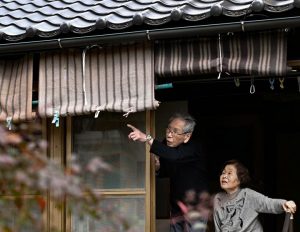Documenting of Hiroshima, Witnesses: Michiko Matsui, Part 2
Apr. 4, 2025
She shares her experience with her colleagues’ sorrows in mind
by Michiko Tanaka, Senior Staff Writer
The “Ayumi group” was established by young people who had tried hard at life for a decade after the end of the war since becoming orphans due to the atomic bombing. Its founding members including Michiko Matsui, 89, resident of Minami Ward in Hiroshima City, continued to issue a newsletter, and step by stem had the group become known by the public.
In 1956, a year after the group’s formation, she appeared in a documentary film titled “Ikite ite yokatta (It’s Good to Live)” directed by Fumio Kamei. Along with screen titling which said, “It was really painful to live for ten years as an orphan,” Ms. Matsui was displayed on the screen. The shooting location was her uncle’s home where she lived at the time. Her parents’ remains, which she had still kept in her room, were also filmed.
With escalation of the movement to ban atomic and hydrogen bombs, her group members had more opportunities to recount their bombing experiences at other places in Japan. Because of that, they were injured in mind by other people’s lack of understanding. For example, when Ms. Matsui went to a site for sharing her experience one day, she saw a banner which read, “Here comes an A-bombed girl.” She was also once asked why she did not have keloids.
In the summer of 1967, there was an event which had the Ayumi group members increase their sense of distrust for the ban-the-bomb campaign. A male member in the group who was fighting against leukemia collapsed at the Atomic Bomb Casualty Commission (ABCC) where he had received a health checkup, and fell critically ill. Ms. Matsui then went to the two world conferences against atomic and hydrogen bombs, which happened to take place in Hiroshima to seek volunteer blood donors. However, those who were related with one of the conferences (hosted a by pro-communist organization) refused to deal with her request, arguing it was under the cold war era and that ABCC was a U.S. facility.
Three people from the other conference donated their blood, but the man who received the transfusion passed away on August 8. He was 35 and the father of two, having married a woman who was also an A-bomb orphan and belonged to the group. Ms. Matsui said, “I did not understand how they could be engaged in a peace campaign without trying to save just one person’s life. I still cannot forgive them.”
In 1971, she had another farewell and encounter. She lost her grandmother, with whom she lived since the war ended but who had been bedridden for a long time in her last years. At the memorial service on the 49th day after her death, Ms. Matsui received an offer of marriage.
The recommended partner was Shozo Matsui, now 96, who was a former high school teacher and successor to his family’s tobacco shop business. He experienced the atomic bombing on the wooden veranda of his home where they still live. His mother, who lived with him, was an A-bomb survivor, too. Her mother-in-law gladly accepted her wish at the time of marriage of bringing the memorial tablets of her parents with her for holding memorial services.
In their 8th year of marriage, she was given another challenge. She developed cancer at the age of 43 and had three-quarters of her stomach removed. Five years later, she saw a colleague in the group who had suffered multiple types of cancer, die. That woman had applied for certification as an A-bomb disease patient, but the application was rejected because she had been just beyond the designated distance of two-kilometers from the hypocenter at the time of the bombing. She died in despair when she was 52.
Ms. Matsui may have been pushed from behind by her anger against the national government, which stubbornly did not recognize the damages caused by the atomic bombing. In 1988, for the first time in some years, she decided to recount her experience in public because she was recommended to do so by a labor union related to the present-day Hiroshima Labor Bureau for which she worked.
Her testimony venue was New York in the United States, where the third United Nations Special Session on Disarmament took place. With the aim to convey voices from as many A-bomb survivors as possible, she made an utmost effort in delivering her message, by visiting a special nursing home for A-bomb survivors prior to her visit, and by incorporating into her speech in English, the experiences of three survivors in the facility with whom she had met.
She communicated what she had to tell there, and then receded from anti-nuclear activity. When she had spare time, she traveled to mountainous areas with her husband who loves mountains; she came to think her post-war period was finally over.
However, the present world is filled with a threatening atmosphere. Ms. Matsui warned, “War drives people mad. So, there is no guarantee an atomic bomb will not be used.” She added, “What happened in the previous war? I would like people to understand the sorrows of my colleagues in the group.” She decided to respond to an interview from the Chugoku Shimbun this time, because she felt it was “the duty of a person who has survived.”
In the morning of August 6 every year, she stays in front of the small Buddhist altar which places her parents’ memorial tablets. Immediately she can remember what she saw at that time. She said, “I cannot help but only cry on this day.” A-bomb survivors may have no end of the post-war period.
(Originally published on April 4, 2025)








